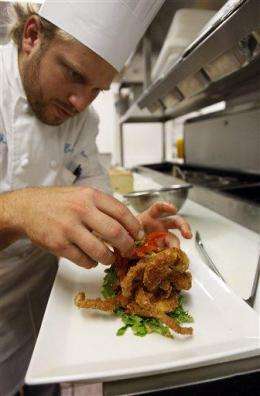Gulf seafood industry tries to shake an oily image

(AP) -- The rich fishing grounds of the Gulf of Mexico are beginning to reopen more than three months after crude began gushing from the sea floor. But those who harvest, process and sell the catch face a new crisis - convincing wary consumers it's not only delicious, but also safe.
As BP PLC closed the books on a defining week in its battle to contain the oil, with engineers finally forcing the surging crude underground with a torrent of mud and cement, people along the Gulf Coast began looking to the future - including the fishing industry, which has a tough sell despite tests showing the catch seems safe to eat.
"We have a huge perception problem," said Ewell Smith, director of the Louisiana Seafood Promotion and Marketing Board. "We have lost markets across the country, and some of them may be lost for good."
The Gulf accounts for a majority of the domestic shrimp and oysters eaten by Americans and about 2 percent of overall U.S. seafood consumption. But with safety suspicions abounding, some wary suppliers appear to be turning to overseas imports.
It took Alaskan seafood five years to overcome such skepticism after the Exxon Valdez spill in 1989, Smith said.
"And remember, Alaska happened when people only had the 5 p.m. and 10 p.m. newscasts," Smith said. "We've had 24-your news and Internet coverage showing the oil spewing across the Gulf for months."
Henry Poynot, who owns Big Fisherman Seafood in New Orleans and has been in business for 26 years, agreed the coverage has had an effect.
"People just can't believe after seeing all that oil going into the Gulf that everything isn't tainted," he said. "It's psychological or something."
Poynot pointed to a longtime customer who bought oysters from him even before the beds closed. Poynot ate two before packaging hers. But when she got home she had second thoughts, fearing they might be oil-tainted. She called Poynot, seeking reassurance.
"After she ate them she said they were good, but she was afraid to buy more," he said.
BP this week finished pumping mud and cement into the well that blew out after the Deepwater Horizon rig exploded April 20, killing 11 workers. Spokesman Max McGahan said Saturday that engineers were still waiting for the cement to harden so work could begin on drilling the final 100 feet of a relief well.
When that relief well intersects the broken well, workers will pump more cement and mud in a "bottom kill" to seal the well permanently.
The well's apparent suffocation coincided with the release of a federal report this week showing that only about a quarter of the oil lost to the leak remains in or along the shores of the Gulf, with the rest having dissipated or otherwise disappeared. The remaining 53 million gallons, though, would be enough alone to rank among the nation's worst spills.
Some fishing grounds remain closed as the oil continues to wash through the Gulf, but state and federal tests have shown samples of seafood in some areas safe to eat. The Food and Drug Administration says chemical dispersants used to break up the oil do not pose a public health concern.
Doug Suttles, BP's chief operating officer, sought to ease consumers' minds and palates by saying this week he would eat Gulf seafood himself and "serve it to my family."
Such assurances appear to be doing little to quell the distaste for Gulf seafood, though.
Some processors are having difficulty selling the seafood they can get, even to long-established customers.
"I've talked to suppliers who have sold 20 years to companies and are now being told no," Smith said. "A lot of people are substituting imported product for Gulf product."
Keath Ladner, owner of Gulf Shores Sea Products in Bay St. Louis, Miss., won't send his 70 boats out, even though shrimp season is open in some Mississippi waters.
"They'd lose money," Ladner said. "Nobody wants it. I can't sell it."
Ladner's main national buyer sent him a letter recently telling him it wouldn't be buying seafood from the Gulf "until further notice," he said.
"They can't convince brokers around the nation that it's a safe product," he said, adding that he came across a 2-square-mile patch of dead, floating fish on Friday about 12 miles off Gulfport, Miss.
"Dead fish all over," he said.
Even at one of New Orleans' toniest restaurants, Commander's Palace, where the menu stars dishes including pecan-crusted Gulf fish topped with jumbo lump crab, barbecued wild white shrimp or crispy soft- shell crab, some customers are hesitant to order.
"We have been selling Gulf seafood the entire time and there's some resistance, some people are worried," said Ti Martin, who helps run the family business, says some customers have been hesitant to order them. "But really, the number of government agencies testing seafood is unprecedented. If it's getting to market, it's good."
©2010 The Associated Press. All rights reserved. This material may not be published, broadcast, rewritten or redistributed.


















